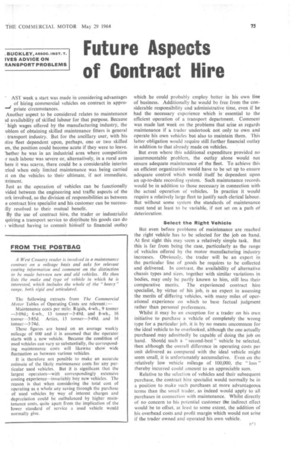FROM THE POSTBAG
Page 77

If you've noticed an error in this article please click here to report it so we can fix it.
A West Country reader is involved in a maintenance contract on a mileage basis and asks for relevant costing information and comment on the distinction to be made between new and old vehicles. He then lists the make and type of vehicle in which he is interested, which includes the whole of the "heavy" range, both rigid and articulated.
The following extracts from The Commercial Motor Tables of Operating Costs are relevant :—
Maintenance costs per mile: Rigids, 4-wh., 9 tonner —3.09d.; 6-wh., 13 tonner-3.49d. and B-wh., 16 tonner-3-85d. Artics, 13 tonner-3.49d. and 16 tonne r----374d.
These figures are based on an average weekly mileage of 600 and it is assumed that the operator starts with a new vehicle. Because the condition of used vehicles can vary so substantially, the corresponding maintenance costs will likewise shoNli wide• fluctuation as between various vehicles.
It is therefore not possible to make an accurate estimate of the likely maintenance costs for any particular used vehicles. But it is significant that the largest operators—with correspondingly extensive costing experience—invariably buy new vehicles. The reason is that when considering the total cost of operating as a whole any saving through the purchase of used vehicles by way of interest charges and depreciation could be outbalanced by higher maintenance costs, quite apart from the implication of the lower standard of service a used vehicle would normally give.




















































































































